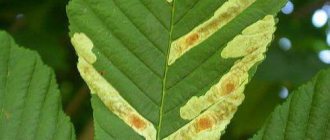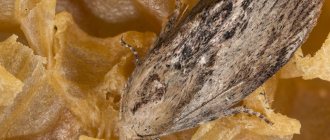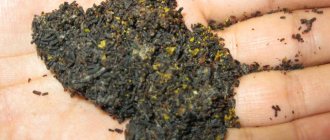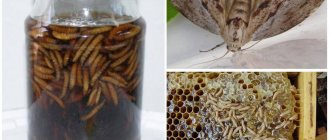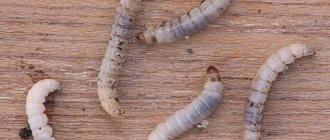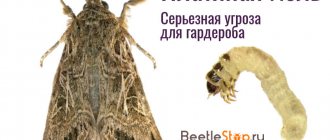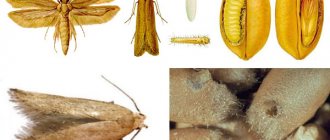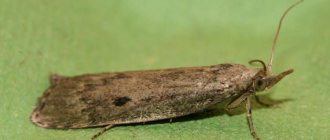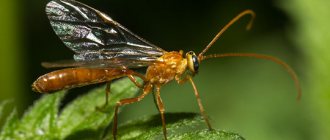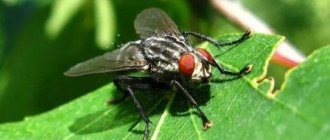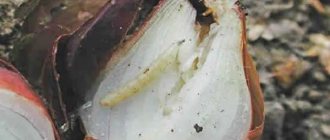Which beekeeper has not witnessed the damage that large and small wax moths cause to the industry? It has been established that the female large wax moth, entering the nest, lays 1500-2000 eggs on the surface of the honeycomb during 26 days of life, from which caterpillars emerge, move to the side wall of the cell, drill a hole in it and on the 4th day reach the middle of the honeycomb , in which exits are made on both sides. The caterpillar's passages are covered with cobweb-like yarn and become invulnerable to bees. An adult caterpillar climbs into a corner, into any crevice of the hive, spins a dense cocoon and turns into a pupa. After 14 days, the pupae enter the butterfly stage.
Bees of strong families drive butterflies out of the hive. For weak families, moths are a dangerous enemy, because each caterpillar consumes 0.4 g of wax for its full development, thereby damaging 500 or more cells. The development of bee colonies severely affected by moths is significantly delayed. Sometimes, due to severe destruction of the nest, bees leave the hive. The pest causes no less harm during storage of honeycombs.
In the apiary, moths are destroyed during routine inspections of bee colonies, and the bottom is periodically cleaned. Moths are removed from honeycombs removed from the hive by lightly tapping the frame. Severely affected honeycombs are removed, the nest is shortened, and it is well insulated, providing the bees with food reserves. When preparing honeycombs that have not been destroyed by moths for storage, they are disinfected.
The moth is destroyed at all stages of its development by keeping the honeycombs at a temperature of -10 °C for 1.5 hours.
Catching moth butterflies
To prevent butterflies from getting into hives or frame storage and laying eggs, it is easier to catch them. To do this, use liter jars filled with 3-4 cm of bread kvass, which are placed on the hives and in places where honeycombs and small frames are stored. The smell of bread kvass attracts butterflies. They fall onto its surface, their wings get wet and they can no longer get out of the jar. In addition to butterflies, no less harmful and annoying flies and midges get into jars.
During honey harvest, bees do not react to kvass and do not get into the jars. During the bee-free period, the jars are covered with plastic lids while the bees are flying. During the first day, from 30 to 70 butterflies end up in each jar. Subsequently, their number decreases. Catching butterflies with little time spent significantly reduces damage from wax moths.
Yu.I.Hupaviy
What kind of insect is this
The wax moth is also often called “shashel”, “motelitsa” or simply “ognevka”. She prefers to settle in places where beekeeping farms are concentrated; in other areas it is extremely rare.
In the environment you can find the so-called large wax moth and small wax moth. The dimensions of the first can reach 35 mm, and the second – do not exceed 24 mm. Representatives of the larger variety are brown or grayish-brown in color, while their more compact counterparts are gray-brown or silver in color.
The wax moth, or moth, in its adult state is not dangerous.
Adults do not have a digestive system, and therefore do not need food. They live off the nutrients accumulated during maturation. Life expectancy is about two weeks.
This insect is quite prolific. One individual is capable of laying about one and a half thousand eggs, from which larvae about a millimeter in size appear a few days later. Due to intensive feeding, they quickly turn into caterpillars up to 3.5 cm long. On the 30th day of its life, the caterpillar is enveloped in a cocoon, from which a new butterfly then emerges.
Acetone against moths
In 4 hive bodies placed on the bottom of the hive, I place 40 dried frames. Many of them were attacked by moths. The upper body was covered and the hole in the ceiling was filled with plywood. I covered all the cracks, and then inserted a sheet of tin with a wall height of 10-12 mm the size of a notebook sheet through the tap hole. First, I put a clean cloth on the piece of paper and poured 100 g of acetone on it. The entrance gap was tightly closed with a plank and covered with plasticine.
On the second day, I removed the ceiling and examined some of the frames in the upper building. There were no longer any living caterpillars. Stopping further review, I covered the upper body again. Two weeks later I removed the ceiling and, when inspecting the frames, did not find a single living caterpillar. The dead caterpillars were black and mummified. This experience gives grounds to recommend acetone as an effective remedy in the fight against wax moths.
P. Batmanov
Preparation and use
Beekeepers can make this product themselves using a recipe. The most commonly used tincture is fireweed. Its production is quite possible at home. You can also purchase it from special companies that sell bee products. Sometimes such medicine is found in the pharmacy. You can buy the insects themselves, and only then prepare an alcohol infusion.
Only large tracks are used. You don't need to take only very mature larvae, which will soon become pupae. The beneficial properties do not depend on age in any way, however, the larger the individual, the less of them will be required for cooking.
The recipe is simple: just pour alcohol or vodka into the larvae in a ratio of 1:10. Thus, a 10% tincture is obtained. To get 25%, you need to fill in a ratio of 1:4. The container is tightly and securely closed and stored for 3 months in a dark, cold room. There it should infuse properly.
Honeycombs under the mesh
For the last two years, I have been storing spare honeycombs in a box with a fine metal mesh, through the cells of which moths cannot pass. Throughout the autumn-winter period, the box with honeycombs is constantly exposed to the air. I cover it with a roof to protect it from rain, and to prevent water from entering from below, I place it on a stand. Under these conditions, moths do not grow in honeycombs, and mold does not grow. There are several tiers of strips nailed to the inside walls of the box: one for nesting frames, the second for store frames. Honey, sealed in frames, despite the damp weather, is well stored and does not sour.
Storage space for honeycomb frames
The place for storing frames should be dry, with a humidity of 70-80%, ventilated, and free of foreign odors. High humidity causes liquefaction of honey and, as a result, its fermentation and souring, honeycombs become moldy and rot, and those containing beebread will have to be discarded later. You can store honeycombs with beebread only by first filling them with honey, thick sugar syrup with the addition of vinegar essence, or covering them with powdered sugar. You cannot store honeycombs with beebread in the cold, as it loses its biological value. Bees on frozen bee bread in early spring raise significantly less brood. Optimal conditions for its storage are achieved at a temperature of +5-10 °C.
Moth is afraid of light
I noticed that the moth attacks mainly dark honeycombs, and if the honeycombs are light, then first of all, the places where the honeycombs collide with each other. The moth prefers dark places, avoiding light. We all know how difficult it is for a moth to part with a hive when the nest is opened. If she flies away from the hive, she immediately rushes to a darkened place.
It is enough to hold moth-infested honeycombs for 1-2 minutes in the sun, and all the larvae jump out. One autumn, for the first time, I hung honeycombs outdoors under a canopy, on the north side, at a height of 2.5 meters from the ground. I made L-shaped hooks from aluminum wire, with the help of which I hung the honeycombs under the canopy on the wire stretched there so that they did not touch each other. This way I store them when the cool nights come in the fall and continue to store them in the spring until warm nights set in. All cells are saved.
Signs of a tired family
The bees become deaf, don’t go to the field much, but sit more at the entrance, looking out with their heads into the yard. At the bottom of the hive, in crumbs, there are worms and their droppings, like onion seeds, gray-reddish in color. With a strong degree of moths in the hive, discarded bundles of cobwebs and moths are visible, and in the highest degree - heaps of crumbs from worn-out honeycombs at the bottom of the hive, as if sawdust of pine bark had been poured there. In the summer, bees entangled in cobwebs come across the hive and in front of it. If you light it well with smoke and then shake the hive or honeycomb, the small moth larvae fall down as rain. If you can disassemble the nest, then it is not difficult to notice the moth cocoons worn out and entangled in cobwebs.
Fumigation with smoke
In the autumn-winter-spring period, when the nests of bee colonies need to be reduced, excess honeycombs have to be taken from the hives and stored separately in the hives or in special rooms. This is where the wax moth begins its harmful work. I smoked the honeycomb with sulfur. Moths did not breed in them, but the bees were reluctant to accept them. I left it in the hives behind the diaphragm for the winter - the honeycombs became moldy from the humidity. I put freshly picked lemon balm in the hives with honeycombs, sprinkled the honeycombs with dry mint, but the moths still started. I treated the honeycombs with vinegar - the moth died and did not start again. But this method has its own drawback, which cannot be ignored - acetic acid causes the wire in the honeycomb to rust and break. An old beekeeper once told me that in order to keep the honeycombs free from moths, he smoked them with ordinary smoke from a beekeeper's smoker. I immediately took advantage of his experience. In a container lined with tin so that mice would not penetrate into it, he hung several tiers of honeycombs at a distance of 12 mm from each other, like in a beehive, closed it tightly and filled it with smoke through a special hole at the bottom. I keep the chimney burning throughout the day. I repeat this fumigation three times at weekly intervals: in autumn and spring. If moths have already started in the honeycombs, then their caterpillars become inactive from the smoke, stop feeding, and die on the second or third day. The smell of smoke from the honeycombs subsequently disappears, and the bees readily perceive them. It is also interesting that moths no longer lay eggs in smoky honeycombs.
V. Nedbeev
Description of the pest
Wax moth (clump or moth), the most widespread and annoying pest of honey bees, belongs to the moth family, a species of moth-like butterflies. There are large moths with a wingspan of 18-35 mm and small (less common) with a wingspan of 16-24 mm, the color is ash-gray. The pest is found everywhere in areas of developed beekeeping.
Important! Knowing at what temperature the pest dies, you can fight successfully: wax moths die at high (+45°C and above) and low (0°C and below) temperatures in any phase of development.
The life cycle of a pest can be represented as follows:
- Eggs. An adult female can lay up to 1,500 eggs on frames in two weeks of life. The eggs are oval white, 0.35×0.5 mm, development period 5-8 days. Eggs laid in early summer develop into adult insects by autumn, and eggs laid in autumn overwinter in hives.
- Larva. The eggs hatch into small white larvae (1 mm). As the larva develops, its body changes to a darker color and it grows into a caterpillar.
- Caterpillar. The length of the caterpillar of the small wax moth is 13-16 mm, the large one is up to 18 mm, with a brown head and 8 pairs of legs. The caterpillar development cycle is 30 days. Each individual requires 1.5 g of wax to develop, so one caterpillar can destroy 500 or more cells, preferably from old dark honeycombs. Gnawing through the walls, they entangle the passages with cobwebs, which causes the death of the bees' brood. When the hive is heavily infested, cannibalism among the caterpillars is observed.
- Doll. After a month, the caterpillars turn into brown pupae, burrowing into secluded corners (cracks, cracks, folds, or gnawing holes). They pupate in cocoons arranged in groups. The length of the pupa of females is 16 mm, of males - 14 mm. The insect spends 9-14 days in the pupal state.
- Butterfly. Adult (imago) female butterflies live 7-12 days, male butterflies - 10-26 days. Butterflies have underdeveloped oral cavities and digestive tracts, so insects do not feed during this developmental phase. The wax moth flies from May to September, being nocturnal.
- In one year, 2-5 generations of pests grow. Only moth eggs and pupae overwinter.
Wax moth caterpillars feed mainly on wax and cause significant damage:
- honeycomb;
- bee brood;
- reserves of beebread and honey;
- frames;
- insulation of hives.
It is better not to store old and poorly built frames, but to melt the wax. The pest practically does not attack foundation and light frames. Honeycombs damaged by moths become unsuitable for storing beebread and honey, and bees are deprived of places for brood. With their excrement and waste, moths make the air in the hive unsuitable, and the bees leave the hive.
Did you know? Moth caterpillars can recycle plastic bags without harming their vital functions: in 6 hours, 50 caterpillars can eat 50 mg of plastic.
Strong bee colonies are able to cope with a pest invasion on their own. Working bees clean the cells, destroy the larvae, gnawing them out of damaged honeycombs, and do not allow adult insects into the hive. When a pupa is found, the bee seals it with propolis, and as a result the pupa dies.
But in some cases, human help is necessary, since with the onset of darkness the fires become more active and the bees stop fighting. Unlike bees, wasps do not produce wax. The building material for honeycombs is recycled wood fibers or clay. For this reason, the wax moth has nothing to feed on in the wasp's nest.
Vinegar helped
An accident helped me get rid of wax moths. There weren't enough dry frames, so I decided to wash the old brown honeycombs. I took a large tank, poured three buckets of warm water into it, added 0.5 liters of vinegar and soaked the honeycombs in this solution. Having treated the frames in this way, I placed them in the hives, and left the solution in the apiary. How surprised I was when I discovered many dead wax moths in the tank. The vinegar solution turned out to be a good bait for them. Now I have no problems with wax moths.
A.S. Solovyov
Damage caused
The adults of moths and moths are harmless, because their mouthparts and digestive organs are not developed. And voracious caterpillars are capable of causing catastrophic damage to an apiary, destroying honeycombs and driving individual bee families out of the hives. Developing pests feed on everything that is in the immediate vicinity:
- honey;
- beebread;
- honeycomb wax;
- pollen;
- royal jelly;
- propolis;
- remains of bee brood;
- insulation;
- the material from which the frames are made.
When infested on a large scale, moth larvae are capable of eating their weaker counterparts and the droppings left by previous generations of parasites.
Along the way of their movement inside the hives, the caterpillars gnaw out numerous tunnels, pollute the internal space with excrement, seal the honeycombs with silk cobwebs, turn the contents of the bee house into dust, and damage the brood. One larva from the day it emerges from the egg until the moment of pupation can destroy up to 500 honeycomb cells. The consequences of wax moth infection can be sad: honey bees weaken, cannot withstand such proximity and leave their hives, and in advanced cases die.
Polyethylene will protect against moths
Honey collection largely depends on the preservation of honeycombs - the “golden fund” of the apiary. Over the course of 5 years I have tested different ways to store them. The following method turned out to be reliable. After pumping out the honey, I immediately place the honeycombs that will be stored in a prepared, clean case. The housings with honeycombs (I keep bees in multi-hull hives) are placed in prepared plastic bags and tied. I take the prepared packages into storage. With this storage method and control check after 1-2 weeks, there are no wax moth larvae. Honeycombs are perfectly preserved for a long time and are always ready for use.
Before installing them in the hive, I lightly sprinkle them with warm water and give them to the bees mixed with wax. I expand the nest with the whole body at once. I also install store extensions. The bees master the honeycomb and quickly remove the foundation.
V.A.Eskiy
Preventive measures
In order to protect the apiary from pest invasion and not incur losses, every beekeeper must keep the bee houses in order, repair them in a timely manner, and eliminate all cracks and gaps through which butterflies can enter the hives. It is necessary to regularly engage in preventive work:
As a preventive measure, you can periodically catch flying moths and moths using homemade baits - containers with a water-vinegar solution or a mixture of honey, bee bread, water and yeast. The bowls should be placed next to the hives in the evening, when the bees no longer fly, and in the morning they should be removed and destroyed by the pests that have drowned in the bait.
Source
Traditional methods
To fight moths, I use proven folk remedies - mint, oregano, wormwood, walnut leaves. At the bottom of the box in which the dry food is stored, lay a layer of fresh green stems of these plants, install the frames tightly, and also place the stems on top of them. For 5 years there were no moths in the boxes, although some boxes were not opened for two years. By the way, oregano or mint, placed around beehives or under honey frames in boxes, reliably repel ants.
S. Kuzminsky
Rodent control in cell storage
Rodents cause great damage to honeycombs. Most often, field, house and forest mice damage honeycombs. Penetrating into the hives in the fall through entrances and cracks, they make nests, eat honey, beebread, bees, and spoil the honeycombs. In addition, bees cannot tolerate the smell of mice, and as a result, colonies spend the winter in constant anxiety. To combat them, various methods are used to isolate frames, set traps and lay out poisonous baits. Black root has a good effect of repelling mice, covering the floor of the vestibule and in the corners of the storage room. Boxes for storing honeycomb frames should have no gaps.
Walnut leaves
For many years I have been storing wax moth dry as follows. In August-September, I collect walnut leaves from the tree, dry them well, and when I start putting the honeycombs in a chest for winter storage, I sprinkle them with these leaves. I also use hops. When it is ripe, I collect it in the forest, dry it and pour it into frames. The honeycombs were never damaged. Many local beekeepers took my advice and always thanked me.
I.M.Makogin
Fighting methods
First of all, the preventive measures described above help against wax moths and their larvae. But the fight against such a scourge requires much more time and effort, and if measures are not taken in a timely manner, the production of food honey in the apiary can be greatly affected. You should not completely rely on the destruction of the parasite by the bee colony.
You should ensure that the size of the bees' nest is correct. After all, its excessive expansion will not only become a more attractive place for various pests, but it will also be more difficult to control and maintain. To do this, you should prepare a special room in which the honeycombs will be stored.
In the case of a large amount of sushi, it has to be treated with a special OKEBM mixture, which is a mixture of gases. The product is supplied at a rate of fifty grams per cubic meter in sealed chambers, at a temperature of 15 degrees Celsius, but not less than ten hours. Naturally, you won’t be able to withstand such fumes on your own, so you have to work in a gas mask.
Other gases can also be used as measures to prevent the occurrence of unnecessary living creatures in the honeycombs. However, it is worth noting that such methods will not necessarily help get rid of the actual presence of wax salt or its larvae. In this case, it is better to take other measures and means.
Remedies for moths and larvae
If preventive measures to protect against wax moths did not perform well, then, most likely, they were simply poorly carried out in the apiary. Therefore, you have to get rid of insects by direct action.
One of the simplest measures to combat wax moths is to keep the honeycombs for an hour at a temperature of fifty degrees Celsius. A slightly more complicated option is to lower the temperature to ten degrees, but with the expectation of a three-hour procedure.
However, beebread honeycombs will not withstand this option. This temperature regime will definitely kill the pest, without harming the honey itself, allowing it to continue to be used as a medicinal product.
As for the hives themselves, it is advisable to warm them up with a blowtorch. But only iron and wooden elements, since it is quite logical that paper and straw elements will not survive this. This can be done before moving the bee family into the hive and before wintering.
Some beekeepers take such measures even in the summer, but it is worth trying to ensure that the bees themselves are not in this structure.
In order to destroy pests, you can also use chemicals. To do this, use formic or acetic acid on damaged honeycomb elements. To do this, they are removed to a previously prepared place. Under no circumstances should this event be carried out in the hives themselves.
You can also get rid of parasites using sulfur gas. No one claims that it is simple and safe, but it definitely allows you to fight the scourge. This product allows you to get rid of the caterpillars themselves, which eat wax treated with this substance.
You can also turn to folk remedies, which are easier and more enjoyable to use.
Folk remedies
Since our ancestors knew how to get rid of wax moths in beehives, using their methods will at least be accessible and reliable. After all, folk methods for eliminating infection have a centuries-old, proven history.
The fight against parasites itself is carried out by simply repelling the smell of the leaves of some trees. The most powerful effects are from nuts, peppermint, mint, oregano, hops and wormwood. You can also use orange peels, elderberries, and garlic.
Since the pungent odors of moths are unbearable, such methods against pests will undoubtedly be very useful in the apiary, especially considering that you do not need to use any gases for this.
You can find out how to most simply and effectively fight against the hated enemy of hives - wax moths - from the following video. Storage of materials and means for this, as well as application standards are also considered. In addition, from such materials you can always glean some new grain of knowledge about beekeeping. You can learn more about the problem from the video.
Peppermint
Knowing that mint tincture is sprinkled on bees during the union of families, it is harmless to bees, but wax moths are afraid of it, I added 30 drops of mint tincture to 50 g of water, lifted the floorboards on both sides of the nest and gradually poured the solution between the frames. I did this in the evening, when the bees stopped flying. On the 2nd day I examined the bees - they behaved calmly, all the larvae fell off, the bees worked together. A week later, the larvae appeared again - I re-treated the bees, and the result was also positive.
Other forms of release
The substance can be part of capsules that are used to treat many diseases; during such therapy it is not recommended to eat alcohol or foods with preservatives. The standard dosage is 1 capsule daily with meals, 2 times a day.
The tincture in its pure form can also be used externally to treat wounds, furunculosis, herpes, and bedsores.
For external use, mix 2 tsp. extract with a 33% dimexide solution.
It is recommended to apply a cloth soaked in the mixture to the affected area for 2 hours; in case of increased sensitivity, use a mixture diluted with water.
If symptoms of irritation occur, the compress should be removed immediately and the drug should be washed off. The substance can also be used for external use; ointments are made from the extract.
The effectiveness of wax moth extract is widely known; its production is mainly carried out by beekeepers. The product helps in the treatment of a large number of diseases, including oncology, tuberculosis, diabetes, infertility, varicose veins and many others.
You can buy the tincture at a pharmacy or prepare it yourself; it has virtually no contraindications or side effects. Wax moth extract is used for external use; the substance is also included in capsules that are prescribed for the treatment of various diseases; ointments are also prepared from it.
So, we talked about the medicinal properties of wax moth: tincture, purpose, treatment. Answered the questions: what is wax moth and how is it useful? How to make a tincture with your own hands? How to take it correctly?
Garlic against moths
Garlic is a good repellent and disinfectant. It is placed in flour and wheat against flour mites. Since ancient times, people have used garlic to disinfect the intestines, etc. This gave me the idea to use garlic against moths. In the fall, when sorting honeycombs before collecting them for long-term storage, I carefully clean the bars and frame strips of propolis and wax and lightly rub them with garlic. The bodies and free hives that I use to store honeycombs are also cleaned from the inside and rubbed with garlic.
In the spring, with the onset of warmth, I put a little finely chopped garlic in the frame storage on the racks and in the housing with honeycombs. I also place one clove of garlic, cut into three parts, on the insulation sheet in each hive. The results are excellent every time: there are no moths in the apiary, the bees are always healthy, the colonies grow well and are always highly productive. Costs are low. For 100 bee colonies, 30 heads of garlic are spent per season.
Processing frames before storage
Before storing honeycomb frames, they are sorted and cleaned of wax and propolis growths. Cleaning allows you to further increase the production of wax and propolis on the farm
It is important to dry the honeycombs after pumping out the honey; this prevents bee theft and they are not exposed to dampness during storage.
The frames are pre-sorted; if there is beebread in the combs, they are selected for placement in the colonies’ nests - for sowing or storing the bees’ food reserves. Separately, full-copper, low-copper, with beebread, unfilled - according to the color of the honeycomb, and unfinished with foundation are placed in storage. Separate storage of frames makes it easier to monitor them, since darker honeycombs are more likely and more strongly affected by wax moths than light and freshly laid ones. In addition, when using them in the future, to expand family nests, it is easier to find frames of the required quality.
Prevention
To prevent caterpillar infestation, frames must be stored correctly. After the season, there is no need to throw away the frames; they must be stored until next summer, frozen for 2 days. Thanks to this, the likelihood of infection of the hive is significantly reduced.
It is also necessary to store frames in lighted, well-ventilated places. Ventilation and insolation create an unfavorable environment for growth and reproduction.
You can use folk remedies, anti-moth or biosafe on a regular basis, since there is no risk of death of the bee colony or deterioration in the quality of honey.
It is necessary to understand that there are no effective and safe means to destroy the pest. It is important to keep bees healthy by taking preventative measures. It is necessary to carefully monitor young colonies, since these are the families that are affected by insects. Preventing the appearance, reproduction, spread of the pest and combating it will increase honey production and reliably strengthen the beekeeping industry.
Source
How to prevent caterpillars from appearing?
Preventative measures to avoid infestation of hives with wax moths:
- maintaining cleanliness in the honeycomb storage, beehives, and the apiary in general;
- regular inspection of hives;
- maintaining optimal temperature in the storage, regular ventilation;
- destruction of heavily damaged honeycombs;
- planting plants around the hives that repel moths (geranium, mint, lavender, marigolds).
Lavender
Small grooves are dug between the hives and filled with water. This helps prevent larvae from moving from one hive to another.
